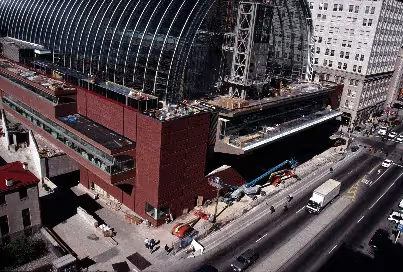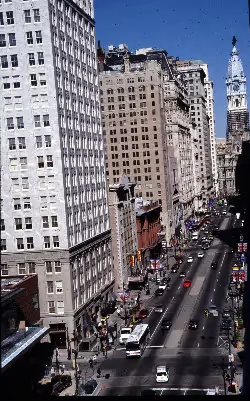A biweekly newsletter with public space news, resources, and opportunities.
A curated dispatch on all things public markets plus the latest announcements from the Market Cities Program.
Please note that these Hall of Shame nominations were written in a moment in time (most over a decade ago) and likely have since changed or even been transformed. If the above entry is now great, or still not so great, go ahead and comment below on how it has evolved or nominate it as a great place.

Is this 2001 building a downtown gem - or "the first great architectural mistake of the 21st century"?

With its alienating blank walls and uninviting pedestrian entrance, the Kimmel Center is at best an interruption of an otherwise reviving Avenue of the Arts. The brick overhangs and prominent car entrance and loading docks further separate the street and the downtown from anything that goes on inside the building. The goal of the architecture seems to be easing the passage of wealthy suburban patrons into and out of the complex while minimizing their contact with the urban surroundings - but still allowing them to feel like they are participating in civic grandeur. The remarkable glass ceiling aptly punctuates the attempt for the building and its patrons to rise above Philadelphia while separating out and looking down upon the people and places that are quietly creating a great city. A $265 million 15-year project, most of the money was raised under the auspices that it would be a contribution to its downtown neighborhood. It is quite obvious that the neighborhood had little input into the design of the building and in no way stands to benefit from its architecture or its clientele. It is unfortunate that the slogan of its fundraising department is "creating a landmark and a legacy _ together."
The pedestrian entrance - which is no more than the wall bent in - only half-heartedly opens to the street. The walls and sidewalks of the building are poorly lit and have no significant signage. The crossings on Broad and Spruce streets are unnecessarily long and unsafe. The center is very easily accessed by the cars and trucks.
The intimidating blank walls and a total absence of amenity are an insulting break in an otherwise pedestrian friendly avenue. The image of the arts it portrays, if any, is that of elitism and inaccessibility to the masses.
Despite indoor public spaces and restaurants, from the street there seems to be no obvious way to experience the building as a pedestrian unless you pay to go to a concert. Even the fact that it is a concert hall or that anything exciting may be going on inside is not readily apparent.
It seems unlikely that anyone would choose to meet outside and mind waiting for someone outside this facility. Likewise, the possibility that patrons of the center would linger in surrounding public spaces or venture out in to the neighborhood does not seem to exist. Most unfortunately, people from the neighborhood would risk being considered undesirables if found lingering around the building and are likely intimidated to be in its vicinity at all.
Excerpted from the Kimmel Center website:
Governor Tom Ridge presented RPAC with a gift of $20 million from the Commonwealth of Pennsylvania. "PhiladelphiaÍs Regional Performing Arts Center is the very best kind of public-private partnership -- individuals, corporations, foundations and public dollars all coming together to build what will be a spectacular landmark. What a wonderful and exciting time for the arts in Pennsylvania," says Governor Ridge.
Believing strongly that the Center will be instrumental to the continued revitalization of Philadelphia and the regional economy, Mr. Kimmel first pledged $12 million to the project in 1993, then contributed another $3 million in 1998.
The Kimmel Center will seat 3,150: 2,500 in Verizon Hall 650 in the Perelman Theater The Center's structure and finishing include: 29,054 total cubic yards of concrete (equivalent to 92 miles of 5-foot wide sidewalk) 317,000 masonry blocks 3,700 total tons of structural steel 2,281 tonnage of rebar (reinforcing steel bars) 61,048 linear feet of structural steel tubing supporting the glass roof 1,400 tons of steel in the arches supporting the glass end walls 156,677 square feet (3.6 acres) of glass glazing 66 tons of weights holding glass end walls 9,300 gallons (860,000 square feet) of paint 594 doors 2.5 miles (13,184 linear feet) of handrails 14 elevators 144 bathroom fixtures (86 for women and 58 for men) 135,000 total cubic yards of dirt were removed from the construction site at Broad and Spruce Streets There are more than 3,900 public parking spaces within three blocks of The Kimmel Center, with an additional 1,000 proposed.


*Please note that these Hall of Shame nominations were written in a moment in time (most over a decade ago) and likely have since changed or even been transformed. If the above entry is now great, or still not so great, go ahead and comment below on how it has evolved or nominate it as a great place.